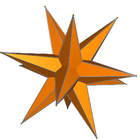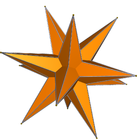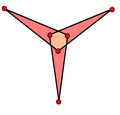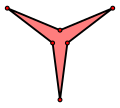Great_triambic_icosahedron
In geometry, the great triambic icosahedron and medial triambic icosahedron (or midly triambic icosahedron) are visually identical dual uniform polyhedra. The exterior surface also represents the De2f2 stellation of the icosahedron. These figures can be differentiated by marking which intersections between edges are true vertices and which are not. In the above images, true vertices are marked by gold spheres, which can be seen in the concave Y-shaped areas. Alternatively, if the faces are filled with the even–odd rule, the internal structure of both shapes will differ.
| Great triambic icosahedron | Medial triambic icosahedron | |
 |
 | |
| Types | Dual uniform polyhedra | |
| Symmetry group | Ih | |
| Name | Great triambic icosahedron | Medial triambic icosahedron |
| Index references | DU47, W34, 30/59 | DU41, W34, 30/59 |
| Elements | F = 20, E = 60 V = 32 (χ = -8) | F = 20, E = 60 V = 24 (χ = -16) |
| Isohedral faces |  |  |
| Duals |  Great ditrigonal icosidodecahedron |  Ditrigonal dodecadodecahedron |
| Stellation | ||
| Icosahedron: W34 | ||
 Stellation diagram | ||

The 12 vertices of the convex hull matches the vertex arrangement of an icosahedron.






